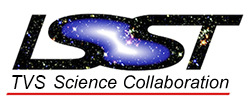Microlensing Subgroup
Welcome to the Microlensing Subgroup!
This page outlines contributors to our group as well as our overall roadmap to studying LSST-discovered microlensing events.
Group Lead: Rosanne Di Stefano, CfA Harvard
Deputy Lead: Rachel Street, Las Cumbres Observatory
Contributors
Slack Channel
#microlensing
Team Telecon and Office Hours
Telecons are held usually by Zoom every two weeks, on:
Tuesday 3pm PDT /
Tuesday 6pm EDT /
Tuesday 10pm UTC /
Wednesday 10am NZST
Look for announcements of the Zoom meeting details on the #microlensing Slack channel (they change each time so its not possible to post a static URL)
Rachel hosts office hours on Skype at the same time on all weeks that don't have a telecon. Please contact her on Slack if you need her Skype ID.
Purpose and Extent of Roadmap
The purpose of the roadmap is to outline the major science topics where LSST data can contribute significantly in the field of microlensing, and to identify preparatory tasks and resources which will be necessary in order to achieve those science goals.
It is envisaged that the tasks included in this roadmap will depend on the standard LSST data products (e.g. alerts, lightcurves) and while it will incorporate tasks to optimize the LSST data products for microlensing (e.g. evaluation of different survey strategies) the production of the standard data products falls under the purview of the LSST Data Management group.
Science Drivers
The bright, nearby microlensing event discovered by amateur astronomer A. Tago has engendered interest in what we can learn from microlensing events away from the Galactic plane (Gaudi 2008, Fukui 2008). The star GSC 3656-1328 was microlensed in a short timescale event, and follow-up observations were made by a number of groups world-wide. In 2016, Gaia discovered two microlensing events - e.g. Gaia16aye - which were followed up by OGLE and other ground-based microlensing collaborations (Wyrzykowski et al 2016a). Microlensing events away from the plane are rare - we can expect a handful of events detected in all-sky surveys. One event per year is expected over the whole sky down to V=15 (Nemiroff 1998; Han 2008). With LSST’s deeper limiting magnitude, however, we can expect a significantly larger number of out-of-plane events. Each out-of-plane microlensing event offers us the opportunity to test our understanding of the mass distribution - in particular the unseen component - throughout the Galaxy.
Microlensing has the significant advantage of being able to detect the gravitational influence of distant non-luminous matter. It is a method capable of detecting stellar remnants such as black holes, neutron stars and white dwarfs (see e.g. Wrzykowski et al, 2016b). Recent work has suggested that observations of neutron star velocities are best described if the kick velocity neutron stars receive from their supernova progenitor is determined from a careful consideration of the physical system of the progenitor (Bray & Eldridge 2016). Further observations of neutron star velocities are required to put this theory on a firm footing. We expect the LSST to detect, via microlensing, a number of stellar remnants including neutron stars. Probability analyses will give likelihoods of lens velocities for any NS lens candidates, and these observations can be set against the predictions from theory.
Whilst the cadence of the primary, wide-fast-deep, survey, is lower than that currently achieved by dedicated planetary microlensing surveys such as MOA and OGLE (i.e. multiple observations per night), the vast scope of LSST opens up unique opportunities to probe different microlensing regimes.
One such regime is mesolensing: lensing by nearby objects (Di Stefano, 2008). In order to maximise the likelihood of lensing, current observations are focused towards the dense stellar fields found in the Galactic Bulge and Magellanic Clouds. However, the combination of larger angular Einstein radii and higher proper motions means the event rate actually increases as the lens distance decreases. For nearby masses (~1-2 kpc) this means there is a relatively high probability of a lensing event being detected, provided the distant stellar background is monitored over a sufficiently long timescale.
The synoptic nature of LSST, combined with deep, high quality photometry makes it ideally suited to this task, and presents the opportunity to extend the microlensing parameter space and explore the mass distribution of the solar neighbourhood and Galactic disk, away from the Galactic centre. This would provide unique insight into the properties of stellar remnants (black holes, neutron stars, white dwarfs), free-floating-planets and help to further constrain the properties of dark matter.
Science Drivers for a Bulge Deep Drilling Field
Outline of Tasks
Resources required
Including computing, personnel, observing facilities in addition to LSST
Timeline
References
Bray, J.C. & Eldridge, J.J. (2016), MNRAS, 461, 3747
Di Stefano, R. (2008), ApJ, 684, 46
Di Stefano, R. (2008), ApJ, 684, 59
Han, C. (2008), ApJ, 681, 806
Nemiroff, R.J.(1998), ApJ,509, 39
Wyrzykowski, L. et al. (2016), Astronomer's Telegram, #9507
Wyrzykowski, L et al. (2017), MNRAS, 458, 3012, arXiv:1509.04899
